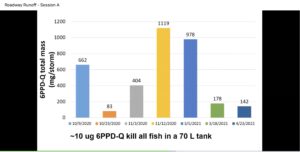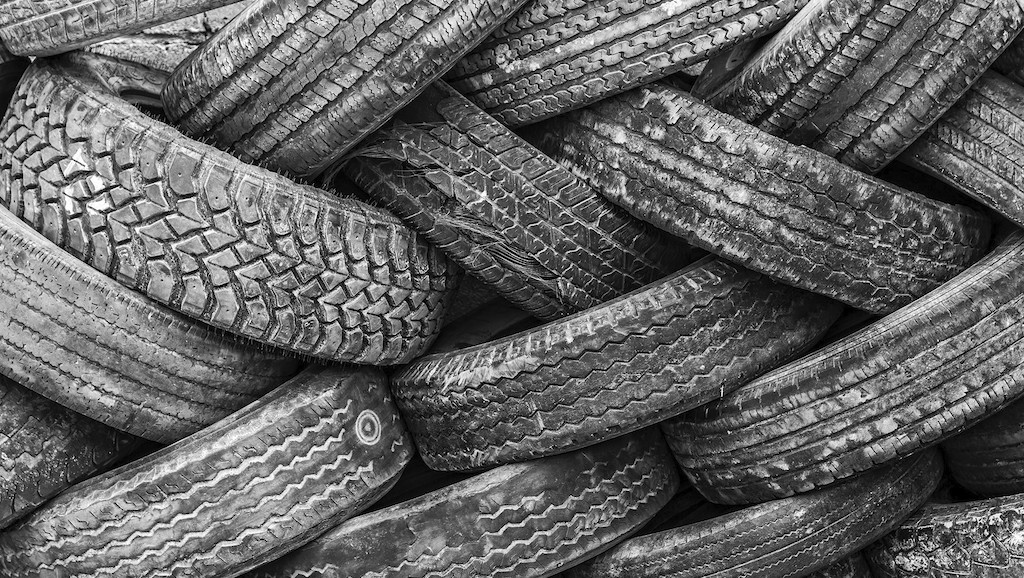The International Conference on Emerging Contaminants (EMCON), hosted virtually this month by the University of Washington, focused on newly identified threats from chemicals and microplastics in the environment. The conference provided an opportunity to hear the latest research on the discovery of a tire-related compound deadly to Puget Sound’s coho salmon.
The cause of what scientists have labeled “urban runoff mortality syndrome” among coho had been a mystery for more than 20 years until it was solved last December by scientists at our affiliate organization the Center for Urban Waters. Their research, in collaboration with scientists at the Washington Stormwater Center and NOAA, identified the deadly chemical as 6PPD-quinone, a transformation product from a tire preservative known as 6PPD.
Since that time, the discovery has touched off a wave of new research. Scientists are looking at where the chemical is found, how it moves through the environment, and whether it is impacting species other than coho, including humans.
Speaking at the conference, Zhenyu Tian of Northeastern University and a former scientist at the Center for Urban Waters reported that 6PPD-quinone is widespread. The compound has now been found across the West Coast in Seattle, Los Angeles, San Francisco, and as far away as China. Scientists assume that it occurs throughout the world. It has turned up as expected in roadside streams, but also in airborne dust particles in homes and appears to move easily through the environment.

Here in Puget Sound, researchers including Tian have been studying 6PPD-quinone in Miller Creek in Seattle. Samples taken from storms in autumn 2020 and spring 2021 showed that the more it rained, the more the chemical washed from roads into the creek, often in deadly amounts. Researchers found 6PPD-quinone at concentrations well over the amount needed to kill coho. “Even if you put this [amount of chemicals] in a raging creek, you still can have a toxicological effect on the coho salmon,” Tian said.
This high toxicity amplifies concerns about how the chemical may be affecting species other than coho. Since its discovery, however, scientists have been surprised to find that while 6PPD-quinone is deadly to coho, chum salmon appear to be unharmed by it. So far, that seems to be the case for other species as well.
A recent study from Japan shows that 6PPD-quinone is not lethally toxic to some freshwater species like the small crustaceans Daphnia magna or zebra fish. Researchers eventually hope to test the effect of the chemical on other species such as rainbow trout and Chinook salmon, which have shown general sensitivity to stormwater but not 6PPD-quinone specifically. Scientists are also investigating whether the compound may be harmful to humans who are exposed to recycled rubber from tires on playgrounds, sports fields, and other environments.
The subject of potential effects on other species has caught the interest of Congress. Last month, Representatives Marilyn Strickland, D-Tacoma, and Derek Kilmer D-Gig Harbor wrote a letter to House and Senate leadership requesting $1.5 million dollars to support additional research into the effects of 6PPD-quinone. [For more information about the letter and how the discovery of 6PPD-quinone has rippled across the policy and scientific landscape, read Christopher Dunagan’s blog, “Discovery of tire-related chemical that kills coho salmon sparks widespread response.“]
In the short term, scientists are looking at ways to keep 6PPD-quinone out of local creeks. Bioswales have been shown to filter out up to 80% of the chemical, but “we simply cannot put bioswales everywhere,” Tian said. “For the long term, we still think 6PPD as an antioxidant should be replaced for a safer chemical.” Until that happens, Tian added, coho populations are expected to remain threatened, and the list of species affected by 6PPD-quinone is likely to grow.
